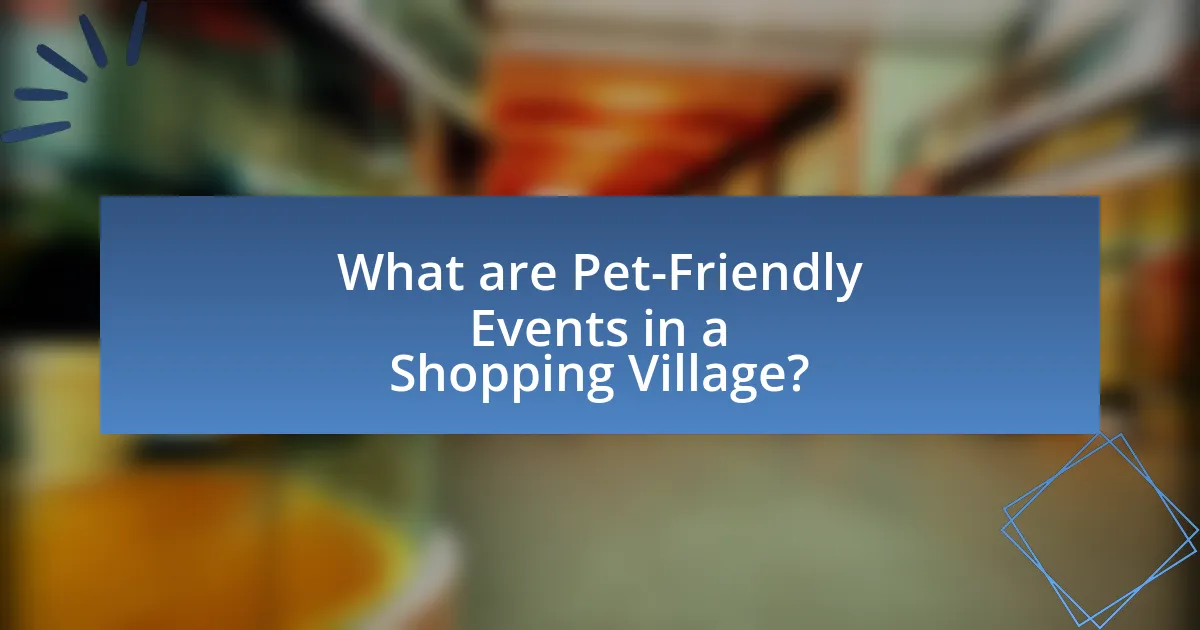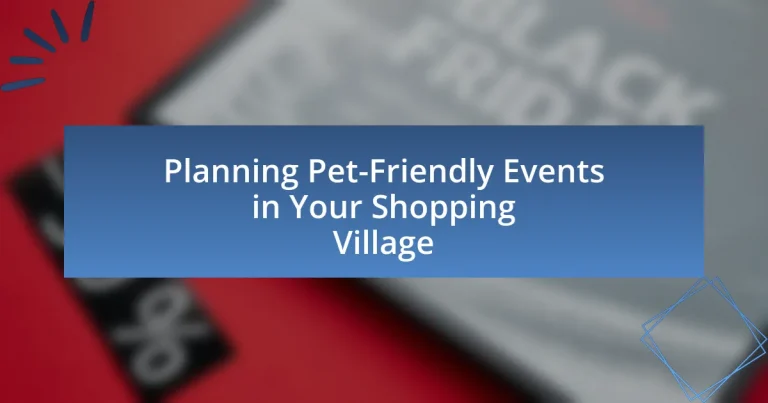The article focuses on planning pet-friendly events in shopping villages, highlighting their significance in fostering community engagement and boosting local businesses. It outlines various types of events, such as pet parades and adoption drives, and discusses the importance of safety and comfort for pets during these gatherings. Additionally, the article covers essential steps for organizing successful events, including venue selection, obtaining permits, and effective promotion strategies. It emphasizes the positive impact of these events on foot traffic and sales, as well as the role of local businesses in enhancing the overall experience for pet owners and their companions.

What are Pet-Friendly Events in a Shopping Village?
Pet-friendly events in a shopping village are gatherings specifically designed to welcome pets and their owners, fostering a community atmosphere. These events often include activities such as pet parades, adoption drives, pet costume contests, and training workshops, allowing pet owners to socialize while engaging their pets in fun and interactive experiences. For instance, a shopping village may host a “Bark in the Park” event, where local vendors showcase pet products and services, and pet owners can participate in games and contests. Such events not only enhance the shopping experience but also promote local businesses and animal welfare initiatives.
Why are Pet-Friendly Events Important for Shopping Villages?
Pet-friendly events are important for shopping villages because they attract a broader customer base, enhancing foot traffic and sales. By allowing pets, shopping villages create an inclusive environment that appeals to pet owners, who represent a significant demographic; approximately 67% of U.S. households own a pet, according to the American Pet Products Association. This increased foot traffic can lead to higher sales for retailers and food vendors, as pet owners are more likely to spend time and money in pet-friendly spaces. Additionally, such events foster community engagement and loyalty, as pet owners often seek out venues that accommodate their furry companions, thereby strengthening the shopping village’s reputation as a welcoming destination.
How do these events enhance community engagement?
Pet-friendly events enhance community engagement by fostering social interactions among residents and their pets. These gatherings create opportunities for pet owners to connect, share experiences, and build relationships, which strengthens community bonds. For instance, studies show that community events can increase social cohesion, as seen in the 2018 Community Engagement Report by the National Recreation and Park Association, which highlighted that 70% of participants felt more connected to their neighbors after attending local events. Additionally, pet-friendly events often attract diverse groups, encouraging inclusivity and participation from various demographics, further enriching the community fabric.
What impact do they have on local businesses?
Pet-friendly events positively impact local businesses by increasing foot traffic and customer engagement. These events attract pet owners and their families, leading to higher sales for shops and restaurants in the vicinity. For instance, a study by the American Pet Products Association indicates that pet owners are likely to spend more when shopping in pet-friendly environments, with 67% of pet owners attending events that allow pets. This influx of customers can also enhance community ties and promote local brand visibility, ultimately benefiting the overall economic health of the shopping village.
What Types of Pet-Friendly Events Can Be Organized?
Various types of pet-friendly events can be organized, including pet parades, adoption fairs, pet costume contests, and dog training workshops. Pet parades allow owners to showcase their pets in a festive atmosphere, while adoption fairs facilitate the rehoming of animals from shelters. Costume contests encourage creativity and engagement among pet owners, and dog training workshops provide valuable skills for both pets and their owners. These events not only promote community involvement but also enhance the shopping village’s appeal to pet owners, fostering a welcoming environment for families with pets.
What are some popular event ideas for pet owners?
Popular event ideas for pet owners include pet parades, adoption events, pet costume contests, and dog training workshops. These events foster community engagement and promote responsible pet ownership. For instance, pet parades allow owners to showcase their pets while encouraging socialization among animals and their owners. Adoption events can significantly increase the chances of finding homes for shelter animals, as seen in studies where such events led to a 30% increase in adoptions. Costume contests not only entertain but also raise awareness for animal welfare causes, while dog training workshops provide valuable skills for pet owners, enhancing the bond between them and their pets.
How can seasonal themes influence event planning?
Seasonal themes significantly influence event planning by dictating the overall atmosphere, activities, and marketing strategies employed. For instance, a spring event may incorporate floral decorations and outdoor activities, while a winter event could focus on cozy indoor settings and holiday themes. Research indicates that events aligned with seasonal themes can enhance attendee engagement and satisfaction, as they resonate with the audience’s current experiences and emotions. According to a study published in the Journal of Event Management, events that embrace seasonal elements see a 30% increase in attendance compared to those that do not. This demonstrates that leveraging seasonal themes can effectively attract more participants and create memorable experiences.
How Can You Ensure Safety and Comfort for Pets at Events?
To ensure safety and comfort for pets at events, provide a designated pet area that is secure and away from high-traffic zones. This area should include shaded spots, fresh water, and comfortable seating to accommodate pets. Additionally, enforce leash policies to prevent pets from wandering and potentially getting lost or injured. According to the American Kennel Club, having a controlled environment reduces stress for pets and enhances their overall experience at events.
What safety measures should be in place for pets?
Safety measures for pets at events include secure enclosures, proper identification, and access to water. Secure enclosures prevent pets from escaping and protect them from potential hazards, while proper identification, such as collars with tags or microchips, ensures lost pets can be returned to their owners. Access to water is essential to keep pets hydrated, especially in crowded or warm environments. These measures are supported by guidelines from organizations like the American Kennel Club, which emphasize the importance of safety and well-being for pets in public settings.
How can you create a comfortable environment for pets and their owners?
To create a comfortable environment for pets and their owners, ensure that the space is safe, clean, and welcoming. Providing designated areas for pets to play, relax, and relieve themselves is essential, as it allows for a stress-free experience. Additionally, incorporating pet-friendly amenities such as water stations, shaded resting spots, and waste disposal stations enhances comfort for both pets and their owners. Research indicates that environments designed with pet needs in mind can lead to increased visitor satisfaction and longer stays, as pet owners are more likely to frequent locations that accommodate their furry companions.

What Steps Are Involved in Planning a Pet-Friendly Event?
Planning a pet-friendly event involves several key steps: identifying the target audience, selecting a suitable venue, obtaining necessary permits, creating a budget, and promoting the event. First, understanding the demographics of pet owners in the community helps tailor the event to their interests. Next, choosing a venue that accommodates pets, such as parks or pet-friendly businesses, is crucial. Additionally, securing permits ensures compliance with local regulations regarding pets in public spaces. Establishing a budget allows for effective allocation of resources, including supplies and marketing. Finally, promoting the event through social media, local pet shops, and community boards increases attendance and engagement. Each of these steps is essential for successfully organizing a pet-friendly event that meets the needs of both pets and their owners.
How Do You Choose the Right Location for the Event?
To choose the right location for a pet-friendly event in your shopping village, assess accessibility, space, and amenities. Accessibility ensures that pet owners can easily reach the venue, while adequate space accommodates both pets and attendees comfortably. Amenities such as pet-friendly facilities, shade, and water stations enhance the experience for pets and their owners. Research indicates that events held in accessible and well-equipped locations attract higher attendance, as seen in studies conducted by the Event Marketing Institute, which highlight the importance of venue features in event success.
What factors should be considered when selecting a venue?
When selecting a venue for pet-friendly events in a shopping village, key factors include accessibility, space, amenities, and safety. Accessibility ensures that both pets and their owners can easily reach the venue, which is crucial for attendance. Adequate space is necessary to accommodate pets and their owners comfortably, allowing for activities and movement without overcrowding. Amenities such as pet waste stations, water bowls, and shaded areas enhance the experience for both pets and attendees. Safety measures, including secure fencing and pet-friendly surfaces, are essential to prevent accidents and ensure a positive environment for all participants.
How can accessibility for pets be ensured at the venue?
Accessibility for pets at the venue can be ensured by implementing designated pet-friendly areas, providing clear signage, and ensuring that pathways are wide and unobstructed. Designated pet-friendly areas allow pets to roam safely while being supervised, and clear signage helps pet owners navigate the venue easily. Additionally, wide and unobstructed pathways accommodate pet strollers and leashed pets, enhancing overall accessibility. These measures are supported by guidelines from organizations like the American Kennel Club, which emphasize the importance of creating inclusive environments for pets in public spaces.
What Permits and Regulations Must Be Considered?
When planning pet-friendly events in a shopping village, several permits and regulations must be considered, including local zoning laws, health and safety regulations, and permits for public gatherings. Local zoning laws dictate where events can be held and may require special use permits if the event is outside standard operations. Health and safety regulations ensure that the event complies with animal welfare standards, including vaccination requirements for pets. Additionally, permits for public gatherings may be necessary to manage crowd control and ensure compliance with local ordinances. These regulations are essential to ensure the safety of both pets and attendees while adhering to community standards.
What local laws govern pet events in shopping areas?
Local laws governing pet events in shopping areas typically include regulations on animal control, health and safety standards, and permits for public gatherings. These laws ensure that pets are vaccinated, leashed, and under control to prevent disturbances or health risks. For instance, many municipalities require event organizers to obtain permits that outline specific guidelines for pet behavior, waste management, and crowd control. Additionally, local health departments may impose restrictions on the types of animals allowed and mandate that pet owners provide proof of vaccinations. Compliance with these laws is essential for the successful and safe execution of pet events in shopping areas.
How can you obtain necessary permits for hosting the event?
To obtain necessary permits for hosting the event, contact your local government or municipal office to inquire about specific requirements. Each jurisdiction has its own regulations regarding event permits, which may include applications for special event permits, noise permits, and health permits, depending on the nature of the event. For example, many cities require a completed application form, proof of insurance, and a detailed event plan outlining logistics and safety measures. Additionally, consulting the local zoning laws can provide insights into any restrictions or guidelines that must be followed.
How Do You Promote the Pet-Friendly Event Effectively?
To promote a pet-friendly event effectively, utilize targeted social media campaigns that engage pet owners and local communities. Research indicates that 70% of pet owners are active on social media platforms, making it an ideal channel for reaching this audience. Create visually appealing content showcasing pets enjoying previous events, and encourage attendees to share their experiences online. Collaborate with local pet businesses and influencers to amplify reach, as partnerships can increase visibility and credibility. Additionally, distribute flyers in pet stores and veterinary clinics, and consider hosting pre-event activities to build excitement and community involvement.
What marketing strategies work best for attracting pet owners?
Effective marketing strategies for attracting pet owners include targeted social media advertising, community engagement through pet-friendly events, and partnerships with local pet businesses. Social media platforms like Facebook and Instagram allow for precise targeting of pet owners based on interests and demographics, increasing the likelihood of engagement. Hosting pet-friendly events fosters community involvement and creates a welcoming atmosphere, encouraging pet owners to visit and participate. Collaborating with local pet shops or veterinarians can enhance credibility and reach, as these businesses often have established relationships with pet owners. According to a survey by the American Pet Products Association, 67% of U.S. households own a pet, highlighting the significant market potential for businesses that effectively engage this demographic.
How can social media be utilized to boost event visibility?
Social media can be utilized to boost event visibility by creating targeted campaigns that engage specific audiences. Platforms like Facebook, Instagram, and Twitter allow event organizers to share event details, visuals, and updates, reaching a wider audience through organic and paid promotions. For instance, using Facebook Events can increase attendance by providing a platform for users to RSVP and share the event with their networks. Additionally, leveraging hashtags on Instagram can enhance discoverability, as posts tagged with relevant keywords can attract users interested in pet-friendly activities. According to a study by Eventbrite, 95% of event creators believe social media is an effective tool for promoting events, highlighting its importance in increasing visibility and engagement.

What Are the Best Practices for Executing a Successful Pet-Friendly Event?
To execute a successful pet-friendly event, organizers should prioritize safety, inclusivity, and engagement. Ensuring a safe environment involves securing areas free from hazards and providing adequate space for pets to roam. Inclusivity can be achieved by offering activities that cater to various pet types and sizes, such as agility courses or pet costume contests. Engaging pet owners through interactive experiences, like training demonstrations or pet wellness workshops, enhances participation. According to a survey by the American Pet Products Association, 67% of U.S. households own a pet, indicating a significant market for pet-friendly events. This demographic insight supports the need for tailored activities that resonate with pet owners and their companions.
How Can You Engage Local Businesses in the Event?
To engage local businesses in the event, you can create partnership opportunities that allow them to showcase their products or services. For instance, inviting local pet stores to set up booths can provide them visibility while enhancing the event’s pet-friendly theme. Additionally, offering sponsorship packages that include promotional benefits, such as advertising in event materials or social media shout-outs, incentivizes businesses to participate. According to a study by the American Independent Business Alliance, local businesses that engage in community events see a 20% increase in customer loyalty, demonstrating the mutual benefits of collaboration.
What partnerships can enhance the event experience?
Partnerships with local pet-related businesses, such as veterinary clinics, pet supply stores, and dog trainers, can significantly enhance the event experience for pet-friendly events in a shopping village. These partnerships can provide resources like pet care services, promotional materials, and expert demonstrations, which engage attendees and create a more enjoyable atmosphere. For instance, collaborating with a local pet supply store can lead to sponsorship opportunities, giveaways, and product showcases that attract pet owners. Additionally, partnering with animal shelters for adoption events can increase foot traffic and foster community goodwill, as seen in successful events organized by shopping districts that prioritize local animal welfare organizations.
How can local businesses contribute to the event’s success?
Local businesses can contribute to the event’s success by providing sponsorship, resources, and promotional support. Sponsorship from local businesses can enhance the event’s visibility and credibility, as seen in community events where local brands often attract larger crowds. Additionally, businesses can offer resources such as venues, supplies, or services that are essential for event execution, which can significantly reduce costs and logistical challenges. For instance, a local pet store might provide pet supplies or services, directly aligning with the pet-friendly theme of the event. Furthermore, local businesses can promote the event through their marketing channels, reaching a wider audience and encouraging community participation, which is crucial for the event’s overall success.
What Activities Can Keep Pets and Owners Engaged During the Event?
Engaging activities for pets and their owners during an event include interactive games, agility courses, and pet-friendly workshops. Interactive games, such as fetch or tug-of-war, foster bonding and physical activity. Agility courses provide mental and physical stimulation, allowing pets to navigate obstacles while owners guide them, enhancing teamwork. Workshops, like training sessions or DIY pet treat making, offer educational experiences that strengthen the owner-pet relationship. These activities not only entertain but also promote socialization among pets and their owners, creating a vibrant community atmosphere.
What types of contests or games can be organized?
Various types of contests or games can be organized for pet-friendly events in a shopping village, including pet costume contests, agility competitions, and best trick contests. Pet costume contests encourage creativity and engagement among pet owners, while agility competitions test the skills and training of pets, fostering a sense of community. Best trick contests allow pets to showcase their unique abilities, further enhancing the interactive experience for attendees. These activities not only entertain but also promote socialization among pet owners and their pets, contributing to a vibrant event atmosphere.
How can educational workshops be incorporated into the event?
Educational workshops can be incorporated into the event by scheduling sessions that focus on pet care, training techniques, and responsible pet ownership. These workshops can feature expert speakers, such as veterinarians or professional trainers, who provide valuable insights and practical demonstrations. For instance, a workshop on basic obedience training can engage pet owners and their pets in interactive learning, enhancing the overall experience of the event. Additionally, providing resources such as handouts or access to online materials can reinforce the information shared during the workshops, ensuring attendees leave with actionable knowledge.
What Feedback Mechanisms Should Be Implemented Post-Event?
Post-event feedback mechanisms should include surveys, focus groups, and social media monitoring. Surveys can be distributed via email or in-person to gather quantitative data on attendee satisfaction, while focus groups allow for in-depth qualitative insights from participants. Social media monitoring can track public sentiment and comments related to the event, providing real-time feedback. Implementing these mechanisms enables organizers to assess the event’s success, identify areas for improvement, and enhance future pet-friendly events in the shopping village.
How can you gather feedback from participants effectively?
To gather feedback from participants effectively, utilize structured surveys and direct interviews. Structured surveys allow for quantitative data collection, enabling easy analysis of participant opinions and experiences. Direct interviews provide qualitative insights, allowing for deeper understanding of participant sentiments. Research indicates that using a combination of both methods increases response rates and the richness of feedback, as shown in a study by the American Journal of Evaluation, which found that mixed-method approaches yield more comprehensive data.
What methods can be used to analyze the success of the event?
To analyze the success of a pet-friendly event in a shopping village, methods such as attendee surveys, social media engagement metrics, and sales data comparison can be employed. Attendee surveys provide direct feedback on participant satisfaction and areas for improvement, while social media engagement metrics, including likes, shares, and comments, indicate the event’s reach and community interest. Additionally, comparing sales data before, during, and after the event can reveal its economic impact, demonstrating whether the event attracted more customers to the shopping village. These methods collectively offer a comprehensive view of the event’s success.
What Tips Can Help Ensure Future Pet-Friendly Events Are Even Better?
To ensure future pet-friendly events are even better, organizers should prioritize clear communication with pet owners regarding event guidelines and amenities. This includes providing detailed information about pet-friendly areas, available resources such as water stations, and designated relief areas. Research indicates that events with well-defined rules and facilities see higher satisfaction rates among attendees, as evidenced by a survey conducted by the American Pet Products Association, which found that 70% of pet owners prefer events that cater specifically to their pets’ needs. Additionally, incorporating feedback from previous events can help identify areas for improvement, ensuring that the needs of both pets and their owners are met effectively.


